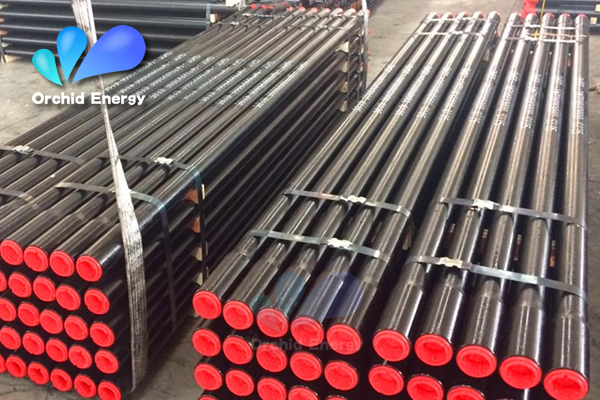-
ꁸ Top
-
ꂅ +86 159 1059 4147
-
ꀥ WhatsApp



-
HOME
-
ABOUT
-
PRODUCTS
- DRILLING TOOLS
- DRILLING MOTORS
- STABILIZERS
- DRILL COLLARS
- DRILLING JARS
- HYDRAULIC AGITATOR
- ANTI STICK-SLIP TOOL
- MULTIPLE ACTIVATION BYPASS VALVE
- DRILL PIPES
- NON-ROTATING PROTECTOR
- X-OVER & SUBS
- DRILL BITS
- MICRO REAMER
- FISHING TOOLS
- RELEASING SPEAR
- RELEASING AND CIRCULATING OVERSHOT
- REVERSE CIRCULATION JUNK BASKET
- JUNK SUB
- FISHING MAGNET
- SAFETY JOINT
- TAPER TAP
- DIE COLLAR
- IMPRESSION BLOCK
- DITCH MAGNET
- MILLING SHOES
- WASHOVER PIPE
- IBOPs
- KELLY VALVE
- FLOAT VALVE
- FULL OPENING SAFETY VALVE
- TOP DRIVE IBOP
- INSIDE BOP
- DROP-IN CHECK VALVE
- WELLBORE CLEANING TOOLS
- CASING SCRAPER
- NON-ROTARY CASING SCRAPER
- CASING BRUSH
- CUTTING BED IMPELLER
- STRING MAGNET
- ROTARY CASING GUIDER
- CASING CUTTER
- SECTION MILL
- WELLHEAD TOOLS
- ELEVATORS
- ELEVATOR LINKS
- POWER TONGS
- MANUAL TONGS
- SLIPS
- SPIDERS
- SPINNING WRENCH
- BUSHINGS
- DRILLING EQUIPMENTS
- MUD PUMP
- VALVE SEAT AND BODY
- PISTON
- CYLINDER LINER
- HYDRAULIC BUCKING UNIT
- JAR TESTER
- FRAC PUMP VALVE RUBBER
- FRAC PUMP VALVE BODY
- FRAC PUMP VALVE SEAT
- FRAC PUMP PLUNGER PACKING
-
PRESS
-
CONTACT


-
HOME
-
ABOUT
-
PRODUCTS
- DRILLING TOOLS
- DRILLING MOTORS
- STABILIZERS
- DRILL COLLARS
- DRILLING JARS
- HYDRAULIC AGITATOR
- ANTI STICK-SLIP TOOL
- MULTIPLE ACTIVATION BYPASS VALVE
- DRILL PIPES
- NON-ROTATING PROTECTOR
- X-OVER & SUBS
- DRILL BITS
- MICRO REAMER
- FISHING TOOLS
- RELEASING SPEAR
- RELEASING AND CIRCULATING OVERSHOT
- REVERSE CIRCULATION JUNK BASKET
- JUNK SUB
- FISHING MAGNET
- SAFETY JOINT
- TAPER TAP
- DIE COLLAR
- IMPRESSION BLOCK
- DITCH MAGNET
- MILLING SHOES
- WASHOVER PIPE
- IBOPs
- KELLY VALVE
- FLOAT VALVE
- FULL OPENING SAFETY VALVE
- TOP DRIVE IBOP
- INSIDE BOP
- DROP-IN CHECK VALVE
- WELLBORE CLEANING TOOLS
- CASING SCRAPER
- NON-ROTARY CASING SCRAPER
- CASING BRUSH
- CUTTING BED IMPELLER
- STRING MAGNET
- ROTARY CASING GUIDER
- CASING CUTTER
- SECTION MILL
- WELLHEAD TOOLS
- ELEVATORS
- ELEVATOR LINKS
- POWER TONGS
- MANUAL TONGS
- SLIPS
- SPIDERS
- SPINNING WRENCH
- BUSHINGS
- DRILLING EQUIPMENTS
- MUD PUMP
- VALVE SEAT AND BODY
- PISTON
- CYLINDER LINER
- HYDRAULIC BUCKING UNIT
- JAR TESTER
- FRAC PUMP VALVE RUBBER
- FRAC PUMP VALVE BODY
- FRAC PUMP VALVE SEAT
- FRAC PUMP PLUNGER PACKING
-
PRESS
-
CONTACT
Drill Pipe Explore Article 3 - Horizontal Directional Drilling Pipe
Introduction:
Horizontal Directional Drilling (HDD) pipes play a crucial role in underground drilling operations, allowing for the installation of utilities and pipelines without disturbing the surface. In this blog, we will explore the materials used, key production processes, application scenarios, international inspection standards, maintenance considerations, and real application cases of HDD pipes. Relevant parameters will be presented in a table format for better comprehension.

1. Materials Used in HDD Pipes:
HDD pipes are typically made from durable and corrosion-resistant materials, ensuring their performance in challenging underground conditions. Commonly used materials include:
1.1 High-Density Polyethylene (HDPE):
HDPE is a thermoplastic polymer known for its excellent strength, flexibility, and resistance to chemicals, abrasion, and corrosion. It is widely used in HDD pipes due to its long-term durability and ease of installation.
2. Key Production Processes:
2.1 Extrusion:
The production process begins with the extrusion of HDPE pipes, where the material is melted and forced through a die to form the desired shape and size. This ensures consistent quality and dimensional accuracy of the HDD pipes.
2.2 Pipe Fusion:
HDD pipes are fused together using a specialized fusion process, such as butt fusion or electrofusion. This creates strong and leak-resistant joints, ensuring the integrity of the pipe during drilling and installation.
2.3 Pipe Coating:
To further enhance the durability and corrosion resistance of HDD pipes, they may undergo coating processes, such as polyethylene encasement or epoxy coating, depending on the specific project requirements.
3. Application Scenarios:
HDD pipes are suitable for a wide range of underground drilling and installation applications, including:
3.1 Utility Installations:
HDD pipes are extensively used for installing utilities such as water and sewer pipelines, gas lines, telecommunications cables, and electrical conduits underground, minimizing surface disruption and environmental impact.
3.2 Crossings:
HDD pipes are ideal for creating horizontal crossings beneath obstacles like rivers, highways, railways, and environmentally sensitive areas, allowing for the installation of pipelines with minimal disturbance.
4. International Inspection Standards:
Adherence to international inspection standards ensures the quality and reliability of HDD pipes. These standards include:
4.1 ASTM F1962:
ASTM F1962 provides guidelines for the installation and testing of HDPE pipes used in gravity flow systems, including HDD applications. It covers aspects such as pipe dimensions, material properties, joint integrity, and hydrostatic testing.
4.2 ISO 9001 and ISO 14001:
ISO 9001 specifies quality management system requirements, while ISO 14001 sets environmental management system requirements. Adhering to these standards ensures that HDD pipe manufacturers maintain consistent quality and environmental best practices.
5. Maintenance and Precautions:
Proper maintenance and precautions are essential for the safe and effective use of HDD pipes. Consider the following:
5.1 Precautions During Use:
- Monitor drilling parameters, such as torque, pullback force, and fluid pressures, to prevent overstressing the HDD pipes.
- Follow proper installation techniques, including using appropriate drilling fluids and ensuring proper alignment and support during pulls.
5.2 Maintenance Methods:
- Inspect HDD pipes for signs of damage or wear, such as cracks, gouges, or deformations, before and after each use.
- Clean the pipes thoroughly to remove drilling residue and debris that could potentially affect performance or cause blockages.
6. Application Cases:
Let's consider two application cases and summarize the relevant parameters in tables:
6.1 Utility Installation Case:
- Project: Water Pipeline Installation
- HDD Pipe Material: HDPE
- Drilling Length: 1,500 ft
- Pipe Diameter: 12 inches
| Key Parameters | Values |
| Drilling Depth | 1,500 ft |
| Average Pullback Force | 50,000 lbs |
| Number of Fusion Joints | 10 |
| Coating Type | Polyethylene Encasement |
6.2 Crossing Case:
- Project: Highway Crossing for Gas Pipeline
- HDD Pipe Material: HDPE
- Drilling Length: 800 ft
- Pipe Diameter: 24 inches
| Key Parameters | Values |
| Drilling Depth | 800 ft |
| Average Pullback Force | 80,000 lbs |
| Number of Fusion Joints | 6 |
| Coating Type | Epoxy Encasement |
These real application cases provide insights into the performance and parameters associated with HDD pipes in different drilling scenarios.
Conclusion:
Horizontal Directional Drilling pipes are vital components in underground drilling applications, offering durability, corrosion resistance, and ease of installation. Understanding the materials, production processes, application scenarios, inspection standards, maintenance practices, and real application cases of HDD pipes is essential for professionals in the drilling industry.
Tags: HDD Pipes





